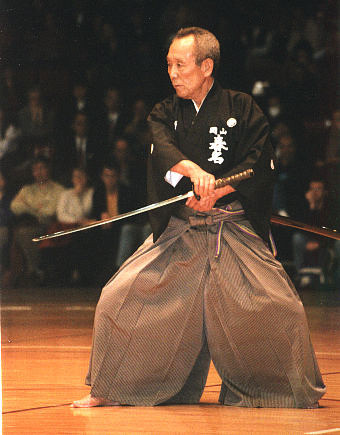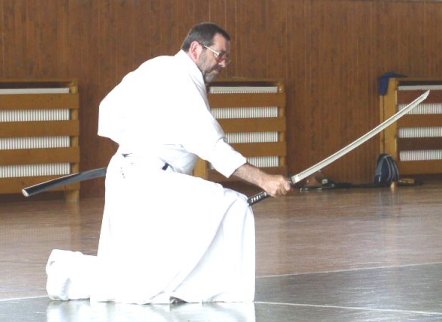|
Iaitō
The is a modern metal practice sword, without a cutting edge, used primarily for practicing iaido, a form of Japanese swordsmanship. Other Japanese swords A real (sharp) katana is called a . In contrast to shinken, iaitō have no cutting edge and are designed for iai/battō practice and are usually unsuited for sword-to-sword contact. These should not be confused with imitation swords primarily made for decorative reasons, which are generally unsafe for martial arts practice. Materials and manufacture Most iaitō are made of an aluminium-zinc alloy which is cheaper and lighter than steel. This use of alloy and a blunt edge also circumvents Japanese legal restrictions on the manufacture of swords made of ferrous metals. As such, Japanese-made iaitō are intended as practice weapons and are not suited for any type of contact. The best alloy blades are rather faithful reproductions of real swords with authentic weight and shape along with similarly high-quality finish and fittin ... [...More Info...] [...Related Items...] OR: [Wikipedia] [Google] [Baidu] |
Katana
A is a Japanese sword characterized by a curved, single-edged blade with a circular or squared guard and long grip to accommodate two hands. Developed later than the ''tachi'', it was used by samurai in feudal Japan and worn with the edge facing upward. Since the Muromachi period, many old ''tachi'' were cut from the root and shortened, and the blade at the root was crushed and converted into a ''katana''. The specific term for ''katana'' in Japan is and the term ''katana'' (刀) often refers to single-edged swords from around the world. Etymology and loanwords The word ''katana'' first appears in Japanese in the ''Nihon Shoki'' of 720. The term is a compound of ''kata'' ("one side, one-sided") + ''na'' ("blade"),1995, (''w:Daijisen, Daijisen'') (in Japanese), w:Tōkyō, Tōkyō: w:Shogakukan, Shogakukan, , entry available onlinhere/span> in contrast to the double-sided ''Tsurugi (sword), tsurugi''. The ''katana'' belongs to the ''nihontō'' family of swords, and is ... [...More Info...] [...Related Items...] OR: [Wikipedia] [Google] [Baidu] |
Iaido
, abbreviated , is a Japanese martial art that emphasizes being aware and capable of quickly drawing the sword and responding to sudden attacks.Christensen, Karen and Allen Guttmann et.al (2001) ''International Encyclopedia of Women and Sports: H-R''. Macmillan Reference USA, Page 553. Iaido consists of four main components: the smooth, controlled movements of drawing the sword from its scabbard (or saya), striking or cutting an opponent, shaking blood from the blade, and replacing the sword in the scabbard.John Nauright, Charles Parrish, edited (2012) ''Sports Around the World: History, Culture, and Practice''. ABC-CLIO. Page 226. While beginning practitioners of iaido may start learning with a wooden sword ( bokutō 木刀) depending on the teaching style of a particular instructor, most of the practitioners use a blunt-edged sword called an iaitō or ''mogitō''.Armstrong, Hunter B. (1995) ''The koryu Bujutsu Experience'' in Koryu Bujutsu: Classical Warrior Traditions o ... [...More Info...] [...Related Items...] OR: [Wikipedia] [Google] [Baidu] |
Shinken
is a Japanese sword that has a forged and sharpened blade. The term ''shinken'' is often used in contrast with ''bokken'' (wooden sword), ''shinai'' (bamboo sword), and iaitō (unsharpened metal sword). Shinken are often used in battōdō, iaidō, and iaijutsu (forms of combative sword-drawing), as well as tameshigiri (test-cutting through targets). In these arts, shinken may be used alongside unsharpened iaitō (居合刀) or mogitō (模擬刀), training swords manufactured for swordsmanship practice. ''Gendaitō'' (現代刀; modern-made swords) are handmade shinken by one of approximately 250 swordsmiths active in Japan at the moment, members of the Japanese Swordsmith Association. These swordsmiths are limited by Japanese law to producing no more than twenty-four swords a year each. This limit, along with highly specialized skills and the need for a great deal of manual labour, accounts for the high price that a Japanese-made shinken (Nihontō) can fetch—starting fr ... [...More Info...] [...Related Items...] OR: [Wikipedia] [Google] [Baidu] |
Iaidō
, abbreviated , is a Japanese martial art that emphasizes being aware and capable of quickly drawing the sword and responding to sudden attacks.Christensen, Karen and Allen Guttmann et.al (2001) ''International Encyclopedia of Women and Sports: H-R''. Macmillan Reference USA, Page 553. Iaido consists of four main components: the smooth, controlled movements of drawing the sword from its scabbard (or saya), striking or cutting an opponent, shaking blood from the blade, and replacing the sword in the scabbard.John Nauright, Charles Parrish, edited (2012) ''Sports Around the World: History, Culture, and Practice''. ABC-CLIO. Page 226. While beginning practitioners of iaido may start learning with a wooden sword ( bokutō 木刀) depending on the teaching style of a particular instructor, most of the practitioners use a blunt-edged sword called an iaitō or ''mogitō''.Armstrong, Hunter B. (1995) ''The koryu Bujutsu Experience'' in Koryu Bujutsu: Classical Warrior Traditions of ... [...More Info...] [...Related Items...] OR: [Wikipedia] [Google] [Baidu] |
Japanese Sword
A is one of several types of traditionally made swords from Japan. Bronze swords were made as early as the Yayoi period (1,000 BC – 300 AD), though most people generally refer to the curved blades made from the Heian period (794–1185) to the present day when speaking of "Japanese swords". There are many types of Japanese swords that differ by size, shape, field of application, and method of manufacture. Some of the more commonly known types of Japanese swords are the ''uchigatana'', ''tachi'', ''ōdachi'', ''wakizashi'', and ''tantō''. Etymology The word ''katana'' was used in ancient Japan and is still used today, whereas the old usage of the word ''nihontō'' is found in the poem the Song of ''Nihontō'', by the Song dynasty poet Ouyang Xiu. The word ''nihontō'' became more common in Japan in the late Tokugawa shogunate. Due to importation of Western swords, the word ''nihontō'' was adopted to distinguish it from the . ''Meibutsu'' (noted swords) is a special designat ... [...More Info...] [...Related Items...] OR: [Wikipedia] [Google] [Baidu] |
:Category:Japanese Words And Phrases ...
{{Commons Words and phrases by language Words Words Words A word is a basic element of language that carries meaning, can be used on its own, and is uninterruptible. Despite the fact that language speakers often have an intuitive grasp of what a word is, there is no consensus among linguists on its ... [...More Info...] [...Related Items...] OR: [Wikipedia] [Google] [Baidu] |
Bokken
A ''bokken'' (, , 'wood', and ''ken'', '(double-edged) sword') or ''bokutō'' (, , 'wood', and ''tō'', '(single-edged) sword') is a Japanese wooden sword used for training in kenjutsu. It is usually the size and shape of a ''katana'', but is sometimes shaped like other swords, such as the ''wakizashi'' and '' tantō''. Some ornamental ''bokken'' are decorated with mother-of-pearl work and elaborate carvings. Sometimes, it is spelled "boken" in English. ''Bokken'' are traditionally composed of red oak or white oak, although any hardwood can be used. In comparison, practice swords made of flexible, soft wood such as bamboo are referred to as ''shinai''. History It is hard to determine precisely when the first ''bokken'' appeared due to secrecy in ancient martial arts training and loose record-keeping. While various mock weapons were surely used during the earlier periods of Japanese history, usage of ''bokken'' in their modern form first emerged during the Muromachi Period (1 ... [...More Info...] [...Related Items...] OR: [Wikipedia] [Google] [Baidu] |
Battōjutsu
is an old term for iaijutsu (居合術). ''Battōjutsu'' is often used interchangeably with the terms ''iaijutsu'' and ''battō'' (抜刀).Armstrong, Hunter B. (1995) "The Koryu Bujutsu Experience" in ''Koryu Bujutsu: Classical Warrior Traditions of Japan'' (ed. Diane Skoss). Koryu Books. Page 32. Generally, ''battōjutsu'' is practiced as a part of a classical '' ryū'' and is closely integrated with the tradition of ''kenjutsu''. It is practised with a live blade (''katana''), often simply as solo kata. The training is for combative effectiveness, through factors such as distancing, timing and targeting. As such, ''battōjutsu'' is not intended for sport-like kendo. List of schools Koryu school: * Shinmei Muso Ryu Battōjutsu (神明夢想流 抜刀術), founded by Hayashizaki Jinsuke (Minamoto no) Shigenobu(林崎甚助(源)重信) (c. 1542–1621) * Sekiguchi Ryu Battōjutsu (or Iai) (関口流抜刀術), founded by Sekiguchi Ujinari (関口氏業) (1636–1716) Gendai s ... [...More Info...] [...Related Items...] OR: [Wikipedia] [Google] [Baidu] |
Tsuba
Japanese sword mountings are the various housings and associated fittings (''Commons:Tosogu (Japanese sword fittings), tosogu'') that hold the blade of a Japanese sword when it is being worn or stored. refers to the ornate mountings of a Japanese sword (e.g. ''katana'') used when the sword blade is being worn by its owner, whereas the ''Commons:shirasaya, shirasaya'' is a plain undecorated wooden mounting composed of a ''Commons:Saya, saya'' and ''Commons:Tsuka, tsuka'' that the sword blade is stored in when not being used. Components *: The ''Commons:category:Fuchi, fuchi'' is a hilt collar between the ''Commons:category:Tsuka, tsuka'' and the ''Commons:category:Tsuba, tsuba''. *: The ''Commons:category:Habaki, habaki'' is a wedge-shaped metal collar used to keep the sword from falling out of the ''Commons:category:Saya, saya'' and to support the fittings below; fitted at the ''ha-machi'' and ''mune-machi'' which precede the ''Commons:category:Nakago, nakago''. *: A hook-sha ... [...More Info...] [...Related Items...] OR: [Wikipedia] [Google] [Baidu] |
Kata
''Kata'' is a Japanese word ( 型 or 形) meaning "form". It refers to a detailed choreographed pattern of martial arts movements. It can also be reviewed within groups and in unison when training. It is practiced in Japanese martial arts as a way to memorize and perfect the movements being executed. Korean martial arts with Japanese influence ( hapkido, Tang Soo Do) use the derived term '' hyeong'' (hanja: 形) and also the term ''pumsae'' (hanja: 品勢 hangeul: 품새). Kata are also used in many traditional Japanese arts such as theatre forms like kabuki and schools of tea ceremony ('' chadō''), but are most commonly known in the martial arts. Kata are used by most Japanese and Okinawan martial arts, such as iaido, judo, kendo, kenpo, and karate. Background Kata originally were teaching and training methods by which successful combat techniques were preserved and passed on. Practicing kata allowed a company of persons to engage in a struggle using a syste ... [...More Info...] [...Related Items...] OR: [Wikipedia] [Google] [Baidu] |







